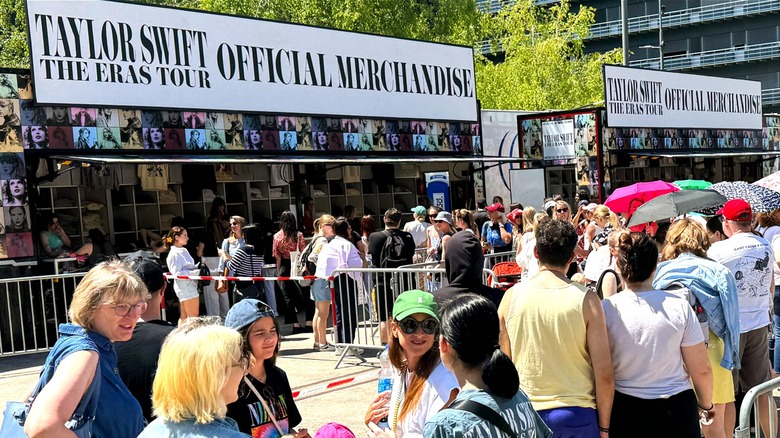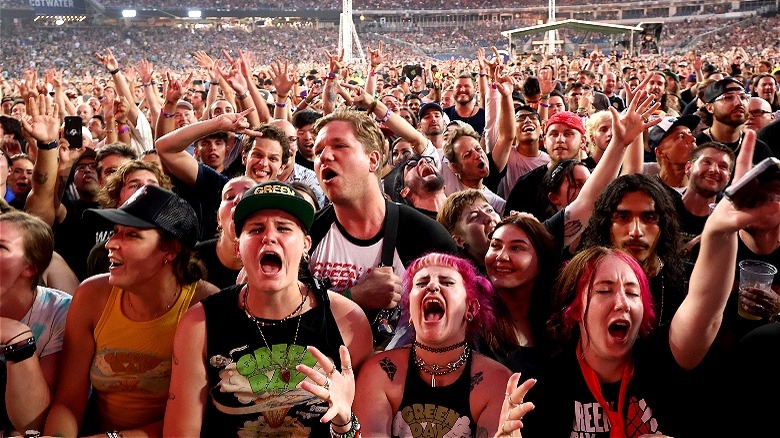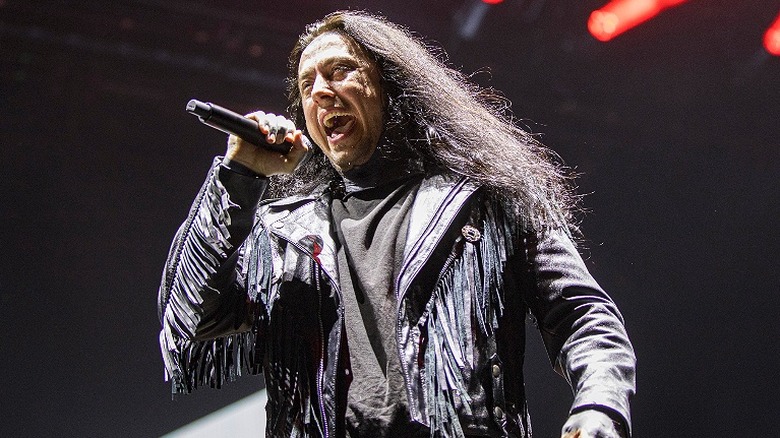Why Does Concert Merchandise Cost So Much?
Whether you're a Swiftie or a metalhead, there's something so thrilling about getting to see your favorite musical acts in concert. From singing along to songs that mean the world to you to enjoying an energetic atmosphere with thousands of like-minded fans, it's an experience most never want to forget. So why not commemorate the evening with a piece of merchandise? The only problem is, your bank account may suffer.
Over the years, typical concert merchandise, including T-shirts, hoodies, concert posters (which could someday be valuable), and more, has steadily climbed in price. Unless you're seeing an up- and-coming act, you should be prepared to spend at least $40 for a basic tour shirt today. And if you have your eye on something fancier, like, say, a jacket, be prepared to shell out some big bucks.
On Green Day's Saviors Tour, for example, which has a momentous setlist comprising albums "Dookie" and "American Idiot" in full, fans can get their hands on a grenade-emblazoned jacket for a cool $200. In response to a photo of the concert merch on Reddit, u/MarkReunitedMCR commented, "Definitely getting that letterman jacket but that price oof. My Paramore letterman jacket I got from the FOB (Fall Out Boy)/Paramore back in 2014 was $90." As for Taylor Swift's worldwide Eras Tour, prices range from $40 oversized T-shirts to $75 hoodies.
Why, exactly, are fans being asked to pay such high prices for concert merchandise? While some may accuse the artists of greed, there are larger factors at play beyond their control.
Venues are taking larger cuts
Inflation, increased production costs, and a lack of steady income from Spotify streams (by the way, here's how much artists actually make off Spotify) play a factor in why concert merch continues to get costlier. However, there's one main reason behind the hefty prices: venues requiring larger cuts from sales. Oftentimes, it's in an artist's contract with the venue that they must fork over a percentage of merchandise profits. This is a practice that's been around for decades, with artists expecting it at each tour stop. The issue is that what used to be miniscule cuts are now massive.
Speaking to Pitchfork, artist Julia Holter said, "... venues are taking increasingly significant merch cuts, sometimes 20 to 35 percent, despite not having contributed in any way to the costs of making merch. This practice takes away from one of the few remaining direct forms of compensation for artists, and will contribute to more artists having to cancel tours."
Some venues are working to implement positive change by joining the 100% Venues campaign, #MyMerch, which is fighting to give artists all merch proceeds and allow fans to know that their money is supporting their favorite musician, not the venue. But until widespread change is achieved, artists, many of whom are financially reliant on concert merchandise sales while on the road, must either hike up prices or simply not play certain venues if they're looking to avoid those cuts.
Artists are fighting back
As discourse spreads about unfair concert merchandise-cut practices, some artists are being more vocal than others so that fans can understand why they need to carefully budget just to get their hands on a tour shirt.
In December 2023, Ronnie Radke (pictured above), the always-straightforward frontman of post- hardcore band Falling In Reverse, announced to fans at the 93X Nutcracker radio festival at The Armory in Minneapolis that he wouldn't be selling any merchandise because the venue wanted a 25% cut. Radke told the crowd (via Consequence Heavy), "What that would mean is, we would have to charge you guys way more to even make any money ... They take our streaming money, they take everything. And now they're taking it out of your pockets. You guys have to spend $100 on a hoodie..."
And two months earlier, artist Jeff Rosenstock shared on the social platform X an Excel sheet that outlined venue merch cuts in each state his tour hit, with percentages ranging from zero at three stops — New Haven, Richmond, and Ottawa — to 25% soft plus 8.875% tax on all non-clothing in New York City.
Rosenstock's post, which received 2.9 million views, resulted in numerous venues announcing that, moving forward, artists would receive 100% of merchandise profits. Diana Azab, marketing director for Denver's Cervantes ballroom, told Pitchfork, "Touring has gotten more and more expensive and artists don't make much money streaming their music, so every bit counts to help them pay expenses on the road."


